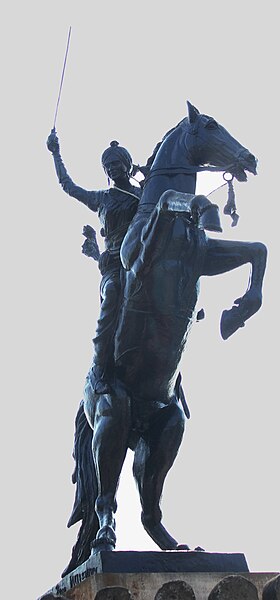The Rani Of Jhansi / Rani Lakshmi bai
Birth Name: Manikarnika
Lost her mother at a tender age of four.
Raised by her father
,educated at home,she took formal training in martial arts which included
archery, horsemanship, self-defence,fencing.
Married to Gangadhar Rao,
the Raja of Jhansi, at the age of 14,she was given the name 'Laxmibai'.In 1851,
she gave birth to a son. Sadly, the child did not survive more than four
months.In 1853, Gangadhar Rao fell
sick and became very weak. So, the couple adopted a child.On 21st November
1853, Maharaja Gangadhar Rao died. Rani Laxmibai was just 18 at that time.
British want Jhansi
Lord Dalhousie introduced
the 'Doctrine of Lapse' which stated that if a ruler of a dependent state died
without leaving a natural born heir,his kingdom would lapse to British Empire.
The British authorities confiscated the state jewels. Also, an order was passed asking the Rani to leave Jhansi fort and move to the Rani Mahal in Jhansi. Laxmibai was firm about protecting the state of Jhansi.
The British authorities confiscated the state jewels. Also, an order was passed asking the Rani to leave Jhansi fort and move to the Rani Mahal in Jhansi. Laxmibai was firm about protecting the state of Jhansi.

"Mai apni Jhansi nahi doongi' (I will not give up my Jhansi)"
Rani Lakshmi Bai started
strengthening the defense of Jhansi and she assembled a volunteer army of
patriots. Women were also recruited and given military training. Rani's forces
were joined by warriors including Gulam Gaus Khan, Dost Khan, Khuda Baksh, Lala
Bhau Bakshi, Moti Bai, Sunder-Mundar, Kashi Bai, Deewan Raghunath Singh and
Deewan Jawahar Singh.She assembled 14,000 rebels and organized an army for the
defense of the city.
Gained back control of
Jhansi
While this was happening in
Jhansi, on May 10, 1857 the Sepoy (soldier) Mutiny of India started in Meerut.
On 4th June 1857, the Sepoy regiment stationed at Jhansi revolted thereby
breaking the British control and enabled Rani Laxmi Bai to rule Jhansi.
Battles
From the period between
Sep-Oct 1857, Rani defended Jhansi from being invaded by the armies of the
neighboring rajas of Orchha and Datia(allies of British rule).
During this time, her
qualities were repeatedly demonstrated as she was able swiftly and efficiently
to lead her troops against skirmishes breaking out in Jhansi. Through this
leadership Lakshmi Bai was able to keep Jhansi relatively calm and peaceful in
the midst of the Empire’s unrest.
Escape from Jhansi
From August 1857 to January
1858 Jhansi under the Rani's rule was at peace.
When the British forces arrived in March 1958,they found it well defended and the fort had heavy guns which could fire over the town and nearby countryside. Sir Hugh Rose, commanding the British forces, demanded the surrender of the city; if this was refused it would be destroyed.
After due deliberation the Rani issued a proclamation:
"We fight for independence. In the words of Lord Krishna, we will if we are victorious, enjoy the fruits of victory, if defeated and killed on the field of battle, we shall surely earn eternal glory and salvation."
On 23rd March,1958,the
British forces under the leadership of Sir Hugh Rose laid a protracted siege on
Jhansi. Rani Jhansi with her faithful
warriors decided not to surrender. The fighting continued for about two weeks.
In the Jhansi army women
were also carrying ammunition and were supplying food to the soldiers. Rani
Lakshmi Bai was very active. She herself was inspecting the defense of the
city. She rallied her troops around her and fought fiercely against the
British.
After a fierce war when the British army entered Jhansi, Rani Lakshmi Bai, tied her son Damodar Rao to her back fought bravely using two swords with both her hands.
 |
| Escape from Jhansi with her son |
Battle at Gwalior
The Rani and Tatya Tope
moved on to Gwalior, where the combined rebel forces defeated the army of the
Maharaja of Gwalior after his armies deserted to the rebel forces.
They intended to occupy a strategic fort at
Gwalior. However, on 18 June 1858,in Kotah-ki-Serai near the Phool Bagh of
Gwalior, a squadron of the 8th (King's Royal Irish) Hussars, under Captain
Heneage, fought the large Indian force commanded by Rani Lakshmibai which was
trying to leave the area.The 8th Hussars charged into the Indian force,
killing many Indian soldiers, taking two guns and continuing the charge right
through the Phool Bagh encampment.
Rani Lakshmibai, the Queen
of Jhansi, dressed as a cavalry leader, was badly wounded; not wishing the
British to capture her body, she told a hermit to burn it. After her death a
few local people cremated her body.
The British captured the
city of Gwalior after three days.
In the British report of
this battle, Hugh Rose commented that Rani Lakshmibai is "personable,
clever and beautiful" and she is "the most dangerous of all Indian
leaders".
Death: 18 June,1858


No comments:
Post a Comment